

Pocketknives for Game Developers : gamedev. Monkey X. OpenFL - Creative expression for desktop, mobile, web and console platforms. Elf Defense / 2D Game concept art on Behance. GDC Vault. NOTE: You can find out how to obtain an unofficial full copy of this archive from a third-party website by reading the info found in this tread.
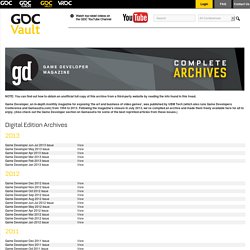
Game Developer, an in-depth monthly magazine for exposing 'the art and business of video games', was published by UBM Tech (which also runs Game Developers Conference and Gamasutra.com) from 1994 to 2013. Following the magazine's closure in July 2013, we've compiled an archive and made them freely available here for all to enjoy. (Also check out the Game Developer section on Gamasutra for some of the best reprinted articles from these issues.) Digital Edition Archives Source Code & Utilities Archive. Essential Math for Games Programmers.
As the quality of games has improved, more attention has been given to all aspects of a game to increase the feeling of reality during gameplay and distinguish it from its competitors.
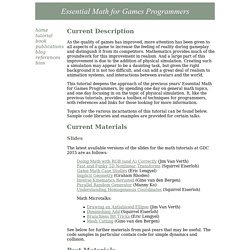
Mathematics provides much of the groundwork for this improvement in realism. And a large part of this improvement is due to the addition of physical simulation. Creating such a simulation may appear to be a daunting task, but given the right background it is not too difficult, and can add a great deal of realism to animation systems, and interactions between avatars and the world. This tutorial deepens the approach of the previous years' Essential Math for Games Programmers, by spending one day on general math topics, and one day focusing in on the topic of physical simulation. It, like the previous tutorials, provides a toolbox of techniques for programmers, with references and links for those looking for more information. Topics for the various incarnations of this tutorial can be found below. Slides. Pilas Engine - Home. LibGDX desarrollo de videojuegos multiplataforma en Java. Os traigo otro framework para desarrollo de videojuegos que está pegando fuerte últimamente, el hecho de que sea multiplataforma utilizando java ayuda muchos a ello, funciona incluso en IOS, lo mejor de todo es que es totalmente libre y gratuita, hablamos de LibGDX. libGDX es un framework para el desarrollo de videojuegos escrito en Java con sus partes más críticas implementadas en C/C++.
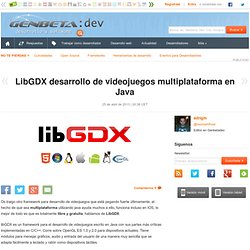
Corre sobre OpenGL ES 1.0 y 2.0 para dispositivos actuales. Tiene módulos para menejar gráficos, audio y entrada del usuario de una manera muy sencilla que se adapta fácilmente a teclado y ratón como dispositivos táctiles. Plataformas soportadas. How to Create a Custom 2D Physics Engine: The Basics and Impulse Resolution. There are many reasons you might want to create a custom physics engine: first, learning and honing your skills in mathematics, physics and programming are great reasons to attempt such a project; second, a custom physics engine can tackle any sort of technical effect the creator has the skill to create.
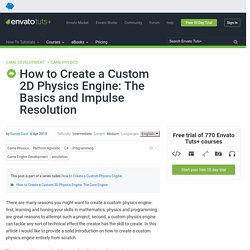
In this article I would like to provide a solid introduction on how to create a custom physics engine entirely from scratch. Physics provides a wonderful means for allowing a player to immerse themselves within a game. It makes sense that a mastery of a physics engine would be a powerful asset for any programmer to have at their disposal. Optimizations and specializations can be made at any time due to a deep understanding of the inner workings of the physics engine. By the end of this tutorial the following topics will have been covered, in two dimensions: Simple collision detectionSimple manifold generationImpulse resolution.
Evolve Your Hierarchy. Refactoring Game Entities with Components Up until fairly recent years, game programmers have consistently used a deep class hierarchy to represent game entities.
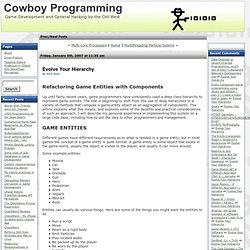
The tide is beginning to shift from this use of deep hierarchies to a variety of methods that compose a game entity object as an aggregation of components. This article explains what this means, and explores some of the benefits and practical considerations of such an approach. I will describe my personal experience in implementing this system on a large code base, including how to sell the idea to other programmers and management. Different games have different requirements as to what is needed in a game entity, but in most games the concept of a game entity is quite similar. Dirty Coding Tricks. [When the schedule is shot and a game needs to ship, programmers may employ some dirty coding tricks to get the game out the door.
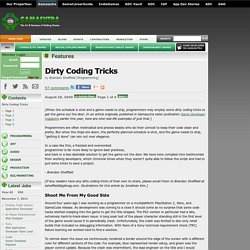
In an article originally published in Gamasutra sister publication Game Developer magazine earlier this year, here are nine real-life examples of just that.] Programmers are often methodical and precise beasts who do their utmost to keep their code clean and pretty. But when the chips are down, the perfectly-planned schedule is shot, and the game needs to ship, "getting it done" can win out over elegance. In a case like this, a frazzled and overworked programmer is far more likely to ignore best practices, and hack in a less desirable solution to get the game out the door. We have here compiled nine testimonials from working developers, which chronicle times when they weren't quite able to follow the script and had to pull some tricks to save a project.
Make Games.
Bartle’s Taxonomy of Player Types (And Why It Doesn’t Apply to Everything) Richard Bartle co-created MUD (Multi-User Dungeon), the text-based precursor to today's MMORPGs, while studying at Essex University.

He ended up formulating the theory that all MUD players could be broken down into four main types: killers, achievers, explorers, and socializers. This theory has since been used in all sorts of game design situations where it doesn't apply - let's look at what exactly it does tell us. MUD is a text-based adventure game (no graphics at all, only text) that had the then-unique attribute of being able to be played alongside other human players. It was one of the first online persistent worlds created, and you can still grab a MUD client today, connect to a server and play. It's a simplified version of pen and paper role-playing games in that the player has to imagine the world according to the information the Game Master (the server and the writer of the game, in this case) provides.
Summary of Bartle's player types. Bartle calls it a bandwagon. Game UI By Example: A Crash Course in the Good and the Bad. How easy is it for your player to put their intention into action, or to understand what's going on in your game?
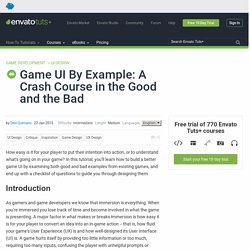
In this tutorial, you'll learn how to build a better game UI by examining both good and bad examples from existing games, and end up with a checklist of questions to guide you through designing them. As gamers and game developers we know that immersion is everything. When you're immersed you lose track of time and become involved in what the game is presenting. A major factor in what makes or breaks immersion is how easy it is for your player to convert an idea into an in-game action -- that is, how fluid your game's User Experience (UX) is and how well-designed its User Interface (UI) is. A game hurts itself by providing too little information or too much, requiring too many inputs, confusing the player with unhelpful prompts or making it hard for a new player to interact.
CompoHub. Indie Game Developer Breakdance McFunkypants. Math for Game Developers Video Series. I've launched a new Youtube series, Math for Game Developers.

Each week I'll be showing how to solve a new problem in game development using math, and I'll be building up a math toolkit that you can use to solve any game dev problem. 1. Moving a character with vectors: 2. More moving characters: 3. 4. 5. This is very basic stuff, just showing the basics of vector maths, buteventually I'll be progressing to explaining the math behind moreadvanced things. I hope to help out people who are just starting their game dev career soplease let me know if I can improve the videos (other than the lowquality audio, a problem I'm working on) or if you didn't understandsomething. Free Game Engine for Indie Game Development.
The Big List Of Game Making Tools. Reverse Design: Chrono Trigger - 1. <map name="admap64899" id="admap64899"><area href=" shape="rect" coords="0,0,728,90" title="" alt="" target="_blank" /></map><table cellpadding="0" cellspacing="0" style="width:728px;border-style:none;background-color:#ffffff;"><tr><td><img src=" style="width:728px;height:90px;border-style:none;" usemap="#admap64899" alt="" /></td></tr><tr><td style="background-color:#ffffff;" colspan="1"><center><a style="font-size:10px;color:#0000ff;text-decoration:none;line-height:1.2;font-weight:bold;font-family:Tahoma, verdana,arial,helvetica,sans-serif;text-transform: none;letter-spacing:normal;text-shadow:none;white-space:normal;word-spacing:normal;" href=" target="_blank">Ads by Project Wonderful!

Your ad here, right now: $0</a></center></td></tr></table> Hello, readers! If you're interested, you can get a high-quality ebook version of this Reverse Design, with lots of improved features. Get a preview of the RD: CT ebook here. Also, this isn't our first Reverse Design. Reverse Design: Final Fantasy 6 - 1. <map name="admap66332" id="admap66332"><area href=" shape="rect" coords="0,0,728,90" title="" alt="" target="_blank" /></map><table cellpadding="0" cellspacing="0" style="width:728px;border-style:none;background-color:#ffffff;"><tr><td><img src=" style="width:728px;height:90px;border-style:none;" usemap="#admap66332" alt="" /></td></tr><tr><td style="background-color:#ffffff;" colspan="1"><center><a style="font-size:10px;color:#0000ff;text-decoration:none;line-height:1.2;font-weight:bold;font-family:Tahoma, verdana,arial,helvetica,sans-serif;text-transform: none;letter-spacing:normal;text-shadow:none;white-space:normal;word-spacing:normal;" href=" target="_blank">Ads by Project Wonderful!
Your ad here, right now: $0</a></center></td></tr></table> You can now get an eBook version of this document that features expanded text and a new bonus essay. Check that out on the books page. You can get the whole reverse design series up to this point. (1) The diminution of character classes. 50 Tips for Working with Unity (Best Practices) » devmag.org.za.
About these tips (Edit: August 2016. I have revised these tips. You can find the new list here.) These tips are not all applicable to every project. They are based on my experience with projects with small teams from 3 to 20 people.There’s is a price for structure, re-usability, clarity, and so on — team size and project size determine whether that price should be paid.Many tips are a matter of taste (there may be rivalling but equally good techniques for any tip listed here).Some tips may fly in the face of conventional Unity development. Process 1. 2. 3. 4. It makes it unnecessary to re-setup each scene.It makes loading much faster (if most objects are shared between scenes).It makes it easier to merge scenes (even with Unity’s new text-based scenes there is so much data in there that merging is often impractical in any case).It makes it easier to keep track of data across levels.
2D Game Art for Programmers. Code Of Honor - HouZone. Derek Yu. Source Filmmaker.